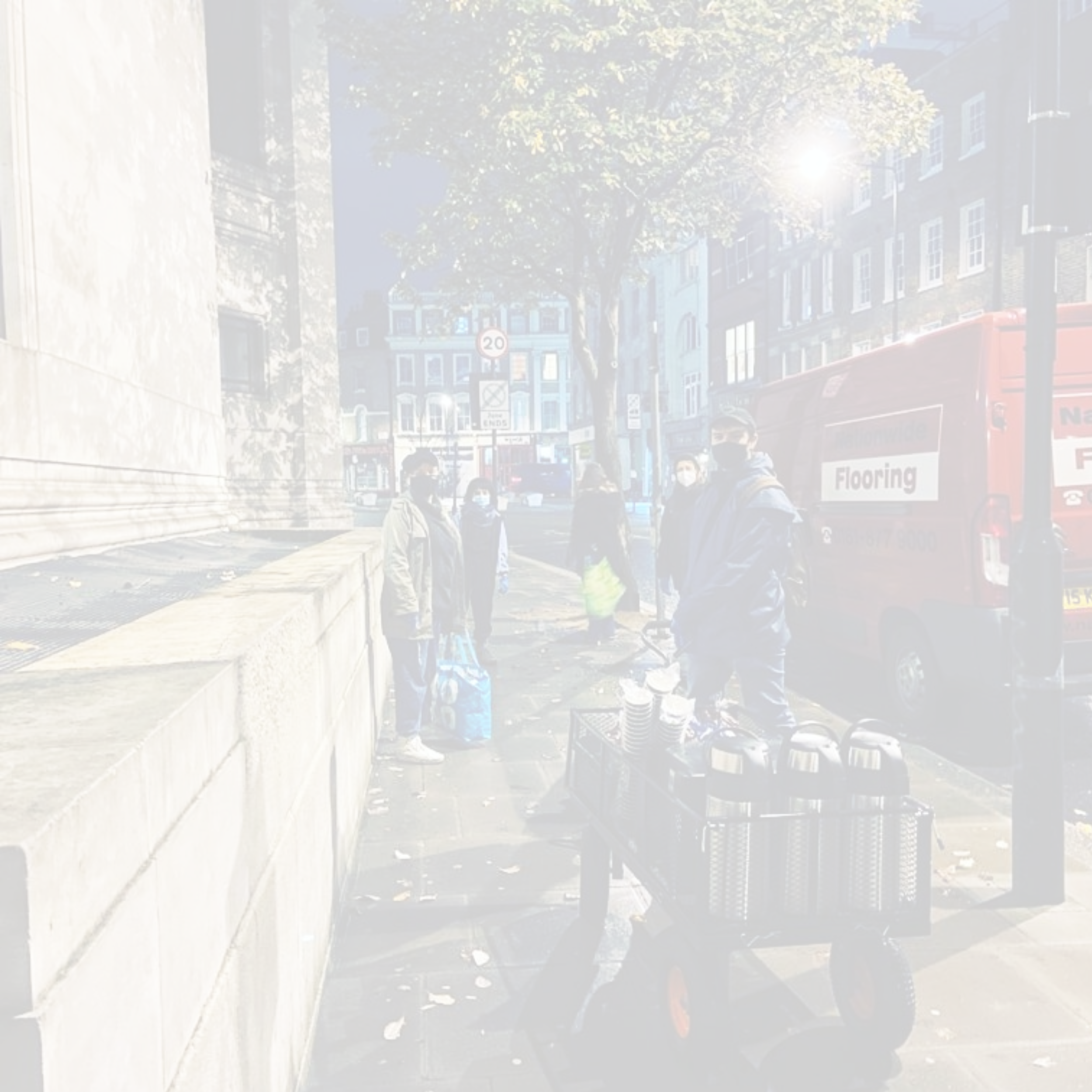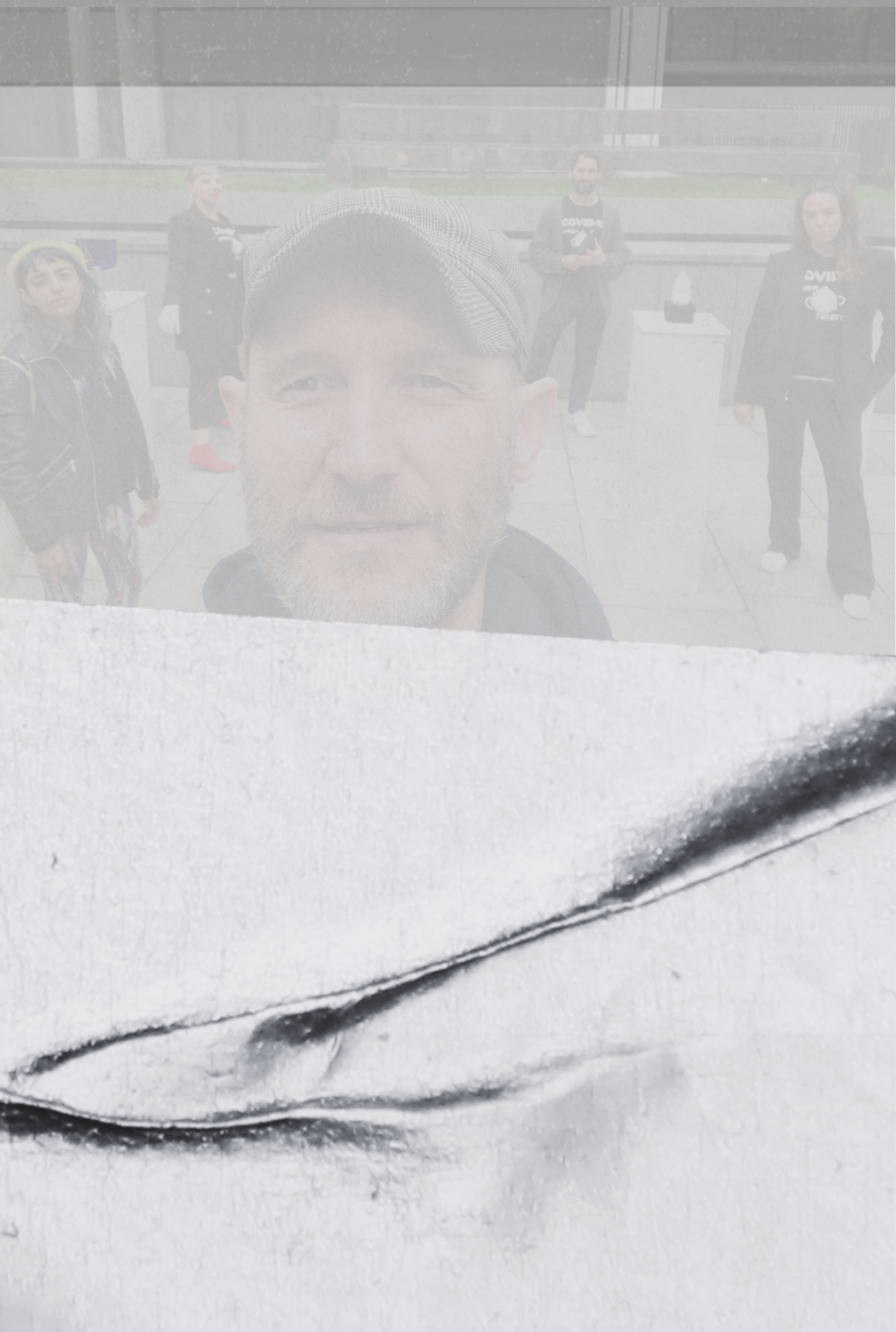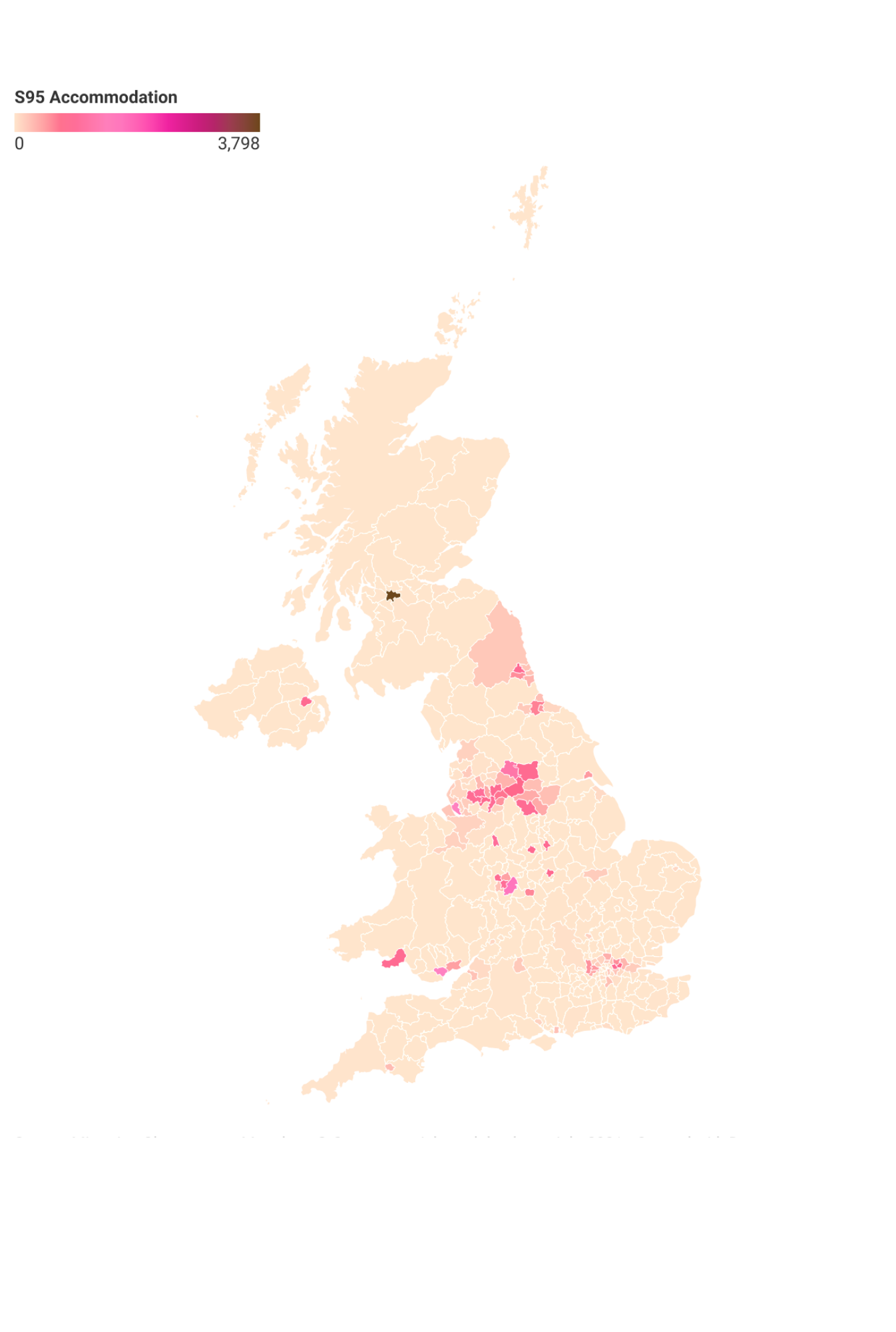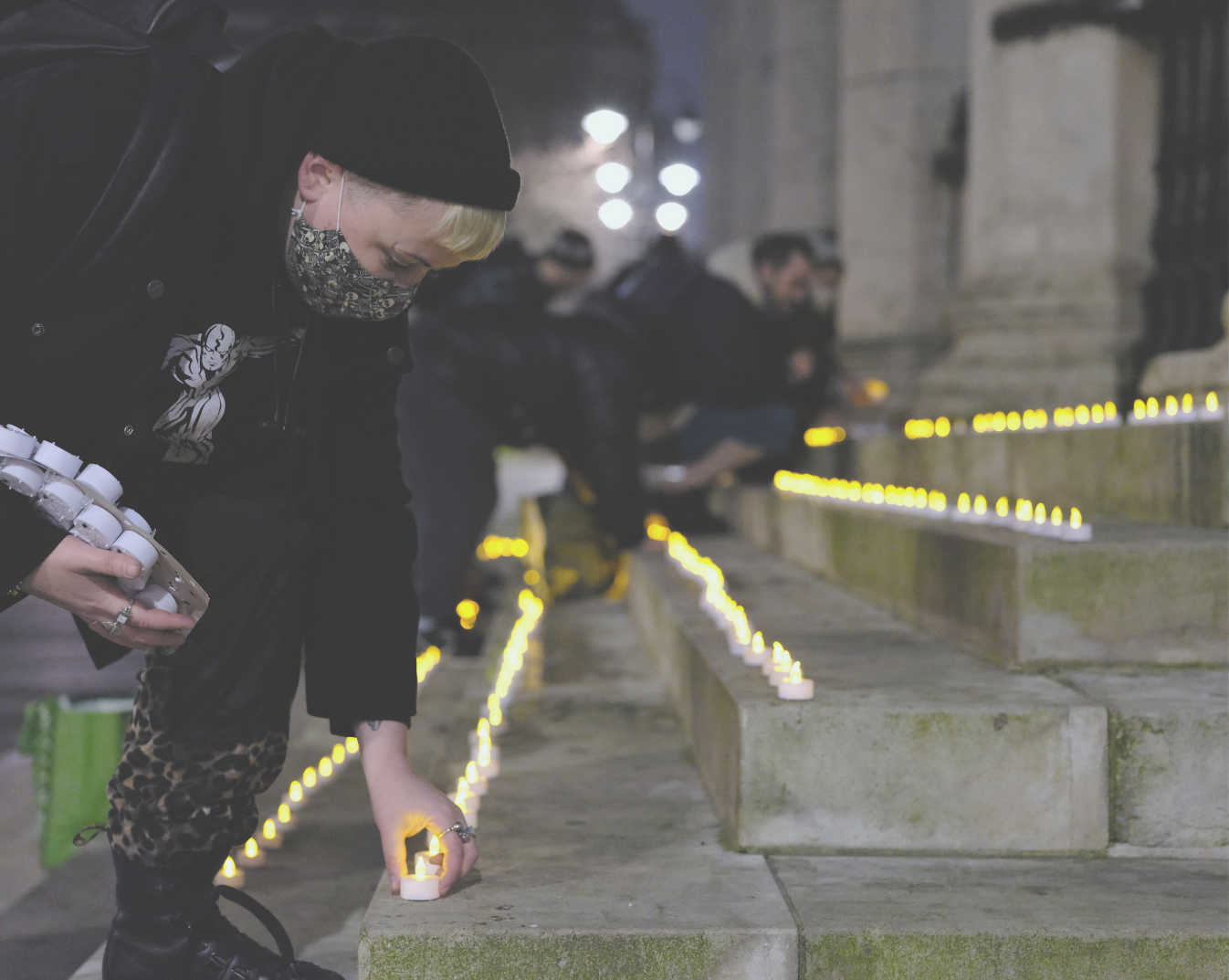
PANDEMIC ON THE EDGE
A VISUAL STORY
In early 2020, the world was changed by a global pandemic – the COVID-19 crisis. The last two years has seen profound change on a scale unseen in well over a generation. Lives were changed, people were divided and communities rallied in response.
Pandemic on the Edge tells the story of what happened to people at the sharp end of society. It a story that was shared with over 1000 people as part of our Secret Museum in late 2021. It includes storymaps, data visualisations, timelines and most importantly, excerpts of real-life testimony of the time.
Ultimately it reflects a story told by people who are working and living with inequality and organising to change it. They are different to the headlines you might have seen. Although some politicians and policymakers had a lot to say in 2020 about bringing people inside, the real picture is much more layered and complicated.
What you will discover here is not what happened with the larger charities or the 'official' government version. Instead, you'll find what went down from the perspective of the grassroots organisers and from the viewpoint of people who are homeless, without filters. At the centre of this visual story are objects and their stories, collected from people affected by homelessness and people on the frontline. Our work on homelessness history has told us that it is this version of events that is often left out of the history books.
With thanks to our funder, the National Lottery Heritage Fund

FIRST RESPONDERS:
SOLIDARITY AND
GRASSROOTS ORGANIZING
IN THE PANDEMIC

IN EARLY MARCH 2020, GRASSROOTS GROUPS MOBILISED
There was a lack of guidance, and it felt like a painfully slow response from the authorities. Smaller organisations were hitting the streets daily and meeting outdoors to pool basic supplies as the shop shelves emptied of sanitiser and other basics.
Previously, some street-based organisations had been viewed as a nuisance. Now, in some places, they were the only ones operating on the front line. Councils gave grassroots volunteers key worker status. In London, Streets Kitchen, Museum of Homelessness, the Outside Project, the Simon Community and the Union Chapel formed the Homeless Taskforce with Street Storage and Tricky Period. Across the UK similar situations emerged, with small, largely volunteer groups mobilising.
4300 MUTUAL AID GROUPS SET UP IN 2020

FRED’S TROLLEY
“It waS the oppoSite to a Siege mentAlity”
Photocredit: Anthony Luvera

THE FLAMINGO
BUT WAS EVERYBODY IN?
The short answer is no.
Although 37,000 people were given COVID secure accommodation, some groups were left out entirely. This includes some mothers with children under 5, who were forced to share crowded and unsafe Home Office accommodation.
THIS FLAMINGO WAS A
WELL LOVED MASCOT
for mothers and children forced to live in one room during lockdown 1. It was down to community groups, like the Magpie Project in Newham to make sure the families had basic supplies.
(And Flamingos for morale.)
Photocredit: Anthony Luvera

IN JUNE 2020 46,000 HOUSEHOLDS WERE IN HOME OFFICE ACCOMMODATION.
This map shows where people were placed

THE BOX
"I think it symbolises community giving. That's what it does. It symbolises that. Because it was the community giving. It weren’t the local authorities. It weren't the charity. It was the community, and that's what it brought to us. It brought us all together. So, I think it brings, for me, togetherness, as well."
Photocredit: Anthony Luvera

THE BUBBLES
“You do what you can. You go out and you take people breakfaSt and you remind them they are loved. The bubble wand? It'S a way of making joy viSible, aS well"
Photocredit: Anthony Luvera

FAULT LINES:
OPPRESSION
ISOLATION
AND PROTEST
MoH outside the Home Office; 2020
Photocredit: David Tovey

THERE WAS AN ELEMENT OF 'BLITZ SPIRIT' TO LOCKDOWN ONE
But during the summer of 2020 it became clear that the toll of the pandemic on people's mental health was significant.
The pressures of societal division, hatred towards minorities and disinformation were also felt keenly in our community, as some of the objects given tell us. In August 2020 some far right groups went 'migrant hunting' in the COVID hotels housing people who were homeless.
The winter lockdown was very hard, with no libraries and day centres open and nowhere for people to warm up in the day. In the West End of London we saw an increase in the enforcement of people living outside, including people having their sleepsites and belongings hosed down.
The immediate legacy of the pandemic, contrary to proclamations about the success of ‘Everyone In’ is much more mixed. Many day centres stopped operating, whilst the national winter night shelter network was also much reduced. That said, the scheme is undoubtedly remembered as a time when people pulled together in ways that have not been seen before.
In February 2021 the Homeless Taskforce installed temporary memorials for all the people in our community who died in 2020. We were mourning a 37% increase in recorded deaths of people who were homeless despite the Everyone In efforts. Only 3% of these were due to COVID and the majority of people died in accommodation.
Photocredit: Anthony Luvera

THE SWEATBAND
By February 2020, more than 90 Polish municipalities have announced they are 'LGBT ideology free zones.'
Photocredit: Anthony Luvera
Local activists respond by creating this 'atlas of hate.' Protests occur in Poland and in the Polish diaspora, including the UK.
"becauSe it'S rainbow colourS, and the Stuff Started getting really bad for LGBTQ PoliSh people, that waS my Sign of Solidarity with them. if you See the pictureS from the proteStS, I'm alwayS wearing thiS."

In the UK, the Everyone In programme did not include LGBTIQ+ homeless people. The Outside Project campaign for, fundraise for and set up an emergency hotel, a domestic violence refuge and a 24-hour service.
2020 sees rising hostilities to LGBTIQ+ people, in particular, Transgender people. By 2021, the European Council condemns “with particular force the extensive and often virulent attacks” on LGBT+ rights in the UK.
Photocredit: The Outside Project
THE UK IS NOW LISTED ALONGSIDE POLAND, HUNGARY AND THE RUSSIAN FEDERATION FOR ITS HUMAN RIGHTS RECORD FOR LGBTIQ+ PEOPLE.

THE LP
This record was released 30 years ago, but for some people in our community the lyrics have not lost their power. The Levellers represent a grassroots movement of squats, sound systems and travelling communities. These histories are also linked with the infamous cardboard city at the Bullring - where we asked participants to assemble for Secret Museum.
In 2021, the communities face renewed threats. History does not seem so distant, but this music continues to serve as an inspiration and source of strength.
"NEW age TravellerS?
not in my age,
not in any age"
-John Major
Conservative Party Conference
1992
Sell Out: “The year was 1991. It seems that freedom’s dead and gone. The power of the rich is held by few. Keep the young ones paralysed, educated by your lies. Keep the old ones happy with the news. Tell the singer not to sing his song. Tell the poet that she's wrong. And in the courts you'll win the case with lies, because you sold them down the river”, you know?"
Photocredit: Anthony Luvera

Reading legislation can give us a good sense of what marginalised communities are facing. There are almost 30 years between these two bills, but they have a few things in common.
Both bills have united a wide range of groups in opposition. London protests in 2020 were attended by LGBTIQ+ groups, migrant groups, sex workers, bargee travellers, climate campaigners, anti-racism campaigners and anti-lockdown campaigners.

In 1994, the Criminal Justice Act took away the duty for local authorities to provide stopping sites for nomadic Gypsy Roma & Traveller (GRT) people, as well as changing trespass laws. This has led to a huge shortage of sites and nomadic people being locked into a cycle of trespass and eviction.
Image: Protestors in London on 07.07.21
The bill gives police new powers to seize gypsy and traveller homes, issue fines of up to £2500 and imprison people. Show your support
#Drive2Survive
Drive2Survive social media flyer
"The Police Bill is the single biggest threat to the traditional way of life of Romany Gypsies and Irish Travellers in our life time. If passed, it will entirely eradicate nomadic life in the UK"
Sherrie Smith,
Co-Chair, Drive 2 Survive

PANDEMIC BY NUMBERS
The pandemic was a time when people around the UK were absorbing data and statistical modelling like never before. The homelessness field is no stranger to data – and produces enormous amounts of it. These graphs and visualisations tell a story by numbers – showing how homelessness has risen and fallen throughout the pandemic.
It begins with ‘Everyone In’, a programme that initially expected to accommodate just over 4,000 people but eventually dramatically surpassed that figure. Although the numbers of people sleeping rough reduced, other forms of homelessness, such as those in temporary accommodation has increased. Since the end of the eviction freeze, possession claims have risen dramatically, eviction rates returned to pre—pandemic levels and very sadly, we have seen an increase in the numbers of people dying whilst homeless despite what happened during Everyone In.

SAVING GRACES:
CREATIVITY
FRIENDSHIP
AND STRENGTH
Although the pandemic was isolating and difficult for so many people, the stories we collected during the pandemic show us that community, solidarity and people’s ability to overcome hardship was stronger than ever.

THE PANTS
"The greatest thing about them is they give you freedom. Prior to having these, I couldn't go to the shops. Prior to having these, I couldn't dare to go to a hospital visit, simply because I would embarrass myself even before I got to the bus stop. So, these became indispensable, and became the first link between myself and probably my best friend in the UK, who is Richard. Richard has boxes of these, which he generously gave me, they were indispensable to my living for the last 18 months."
Photocredit: Anthony Luvera
friendShip found amidSt the Survival
StruggleS of temporary accommodation,
a situation which increasing numbers
of people find themselves in:

THE CARDBOARD BOX
"During the pandemic, I didn’t Survive,
I lived the pandemic.
There waS no Surviving about it.
Photocredit: Anthony Luvera
If you Survive, then you were Struggling.
I waSn’t Struggling, one bit.
I had me cardboard box..."

THE TEA
"Right now, as I record this, it's the end of June 2020, and I'm currently in a Hotel apartment in Marylebone in London as part of the #HeathrowHomeless housed in emergency accommodation for the duration of the Covid19 pandemic lock-down, that ends next week, at which time I'll return to sleeping at Heathrow Airport Terminal 5 which I've used as a bedroom for the past two years.
But this tin here has been a constant through all of it. It tells my story, who I am entirely, from the shop it was purchased, its fabulous artistic design and even the legend of how it came about, it just simply captures the essence of who I am."
Photocredit: Anthony Luvera

“FOR THE FIRST TIME, THE SCALE OF THE ROUGH SLEEPING POPULATION IN ENGLAND HAS BEEN MADE CLEAR, AND IT FAR EXCEEDS THE GOVERNMENT’S PREVIOUS ESTIMATES.”
gARETH dAVIES, HEAD OF THE NATIONAL AUDIT OFFICE | JAN 2021

THE PORTRAIT
"But this makes me proud, that he done this for me. Makes me proud I done my testimony. And it makes me proud to hang it in the museum that people may be homeless, people can see it, and maybe can share the power with me. Because, this painting giving me power and strength."
Photocredit: Anthony Luvera























